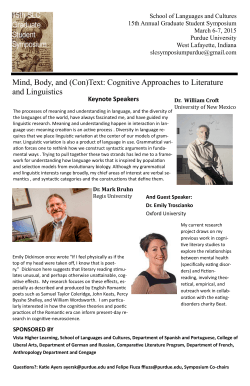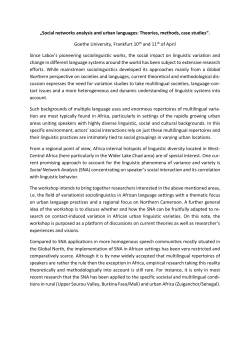
Words in time: the effects of word frequency, word age
Words in time: the effects of word frequency, word age, and discourse topic on the progression of sound change* Paul Foulkes (University of York, UK) There is now abundant evidence that people possess extensive episodic memories about their linguistic experiences (reviewed by Foulkes & Hay 2015, inter alia). These memories may reflect, for example, aspects of speaker identity or stylistic and situational variation. The cognitive representation of a word is thus not simply a highly abstract and minimalistic code; it also contains, at some level, detailed information about the word’s usage in social contexts. How might episodic memories of words contribute to sound change? Regular sound change has traditionally been investigated and modelled in terms of abstract structures such as phonemes, and it is indeed beyond question that change eventually affects abstract categories. However, questions relating to word-specificity remain controversial, especially in predictions about language variation and change. Early literature on the trajectory of sound change predicted word-specific effects, and generated polarised debate on the degree to which there can be lexical diffusion of change (e.g. Schuchardt 1885, Zipf 1929, Trubetzkoy 1939, Chen & Wang 1975, Labov 1994, Phillips 2006). Labov (1994, 2010), for example, acknowledges lexical diffusion only in the case of phoneme substitution changes (i.e. lexical rules), and strongly rejects lexical effects as a factor in other cases. In this presentation we investigate lexical factors with reference to an ongoing change affecting wordmedial intervocalic /t/ in New Zealand English (NZE). In words such as city the dominant pronunciation has shifted over time from [t] to [d/ɾ]. Voicing or tapping processes such as this have often been described as lenition changes, and can be considered regular sound changes. In many ways, our overall analysis is similar to many standard and well-known studies of sound change. We investigate the production of the variable in 98 speakers with birth dates spanning 120 years, and determine the social and linguistic factors conditioning its variation. However, the types of potential factors we consider are much broader than is typical in language variation and change studies. In particular, we focus on potential effects that would be predicted to be present if lexically-specific episodic memory is involved in the production (and, presumably, perception) of lexical items. We test three predictions regarding the role of episodic memory in the progress of change: Prediction 1: frequent words lead lenition change Prediction 2: words used more by younger speakers are produced with more new variants Prediction 3: speech about older events elicits older variants All three predictions are supported: (1) frequent words lead the change, and the effect of frequency increases over time; (2) the distributions of individual words affect their participation in the change (words favoured by younger speakers are produced with more of the newer variants); and (3) the topic of conversation affects which variant is favoured (discussion of older topics elicit more of the older variants). Together, these findings provide strong evidence that phonetic distributions of word-level representations are implicated in the course of sound change. * This study was conducted with Jen Hay (University of Canterbury, NZ) References Chen, Matthew Y., and William S.-Y. Wang. 1975. Sound change: Actuation and implementation. Language 51.255281. Foulkes, Paul, and Jennifer Hay. 2015. The emergence of sociophonetic structure. The Handbook of language emergence, ed. by Brian MacWhinney and William O’Grady, 292-313. Oxford: Blackwell. Schuchardt, Hugo. 1885. Über die Lautgesetze: Gegen die Junggrammatiker. Berlin: Oppenheim. [Reproduced in translation as On sound laws: against the Neogrammarians. Schuchardt, the neogrammarians, and the transformational theory of phonological change, Theo Vennemann & Terence H. Wilbur. Frankfurt: Athenäum, 1972.] Labov, William. 1994. Principles of linguistic change. Vol. 1: Internal factors. Oxford: Blackwell. Labov, William. 2010. Principles of linguistic change. Vol. 3: Cognitive factors. Oxford: Blackwell. Phillips, Betty. 2006. Word frequency and lexical diffusion. Basingstoke: Palgrave Macmillan Trubetzkoy, Nikolai. 1939 [1969]. Principles of phonology. Berkeley & Los Angeles: University of California Press. Zipf, George K. 1929. Relative frequency as a determinant of phonetic change. Harvard Studies in Classical Philology 15.1–95.
© Copyright 2025





















